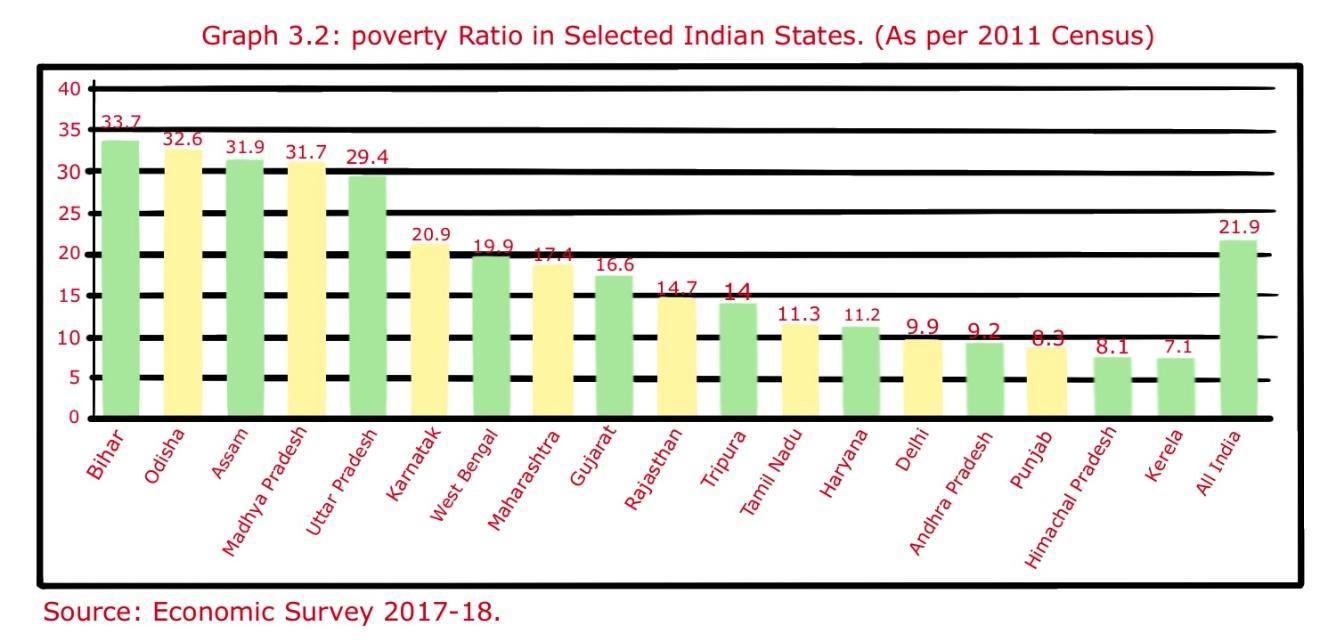About 270 million (or 27 crores) individuals in India live in poverty (2011-12). This additionally implies that India has the most considerable single centralization of the poor on the planet. It shows the graveness of the challenge.
Apart from being poor, poverty also has various dimensions like hunger, lack of shelter, inability to access education, healthcare, clean water, and sanitation. Most importantly, it implies living with a feeling of powerlessness.
Social scientists’ view of poverty based on social exclusion and vulnerability is now becoming very common. Now poverty is looked at through other social indicators like
- Illiteracy level
- Lack of general resistance due to malnutrition
- Lack of access to healthcare
- Lack of job opportunities
- Absence of admittance to safe drinking water, sterilization, and so forth
Poverty Line
- An individual is viewed as poor, assuming their pay or utilization level falls under a minor level essential to satisfy the fundamental necessities
- As means of fulfilling these basic needs vary; therefore, the poverty line may vary with time and place
- In India, the physical quantities of basic needs are multiplied by their prices in rupees
- The current concept for food prerequisites while assessing the neediness line depends on the ideal calorie necessity
- India’s acknowledged everyday calorie necessity is 2400 calories for every individual in rural regions and 2100 calories for each individual each day in the metropolitan areas
Global Poverty Scenario
In different countries living in extreme economic poverty, the proportion of people in different countries has fallen from 36 percent in 1990 to 10 percent in 2015. This is an example of a global poverty scenario.
Poverty Estimate Trends in India
- There is a considerable decrease in poverty proportions in India from around 45% in 1993-94 to 37.2% in 2004–05 to about 22% in 2011–12
- But the degree of people living in poverty declined in the past twenty years (1973-1993), the amount of poor fell from 407 million each 2004-05 to 270 million 2011-12 with a typical yearly diminishing of 2.2 rate centres during 2004-05 to 2011-12

Types of Poverty in India
Vulnerable Groups
- Certain social groups like Scheduled Caste, Scheduled Tribe and economic groups like rural agricultural labourers and urban casual labourers are more vulnerable to poverty
There is inequality of income within a family. As types of poverty are considered, in families living in poverty all the members are suffering, but some suffer more than others.
In various families, females are denied equal access to resources available to the family.

Inter-State Disparities
- The proportion of poor people is not the same in every state
- States like Bihar and Odisha have poverty line levels above all India levels
- States like Punjab and Haryana have customarily prevailed regarding lessening destitution with the assistance of high agrarian development rates. Kerala has zeroed in on human asset advancement
- In West Bengal, land change measures have helped in decreasing neediness
- In Andhra Pradesh and Tamil Nadu, the public appropriation of food grains might have been answerable for the improvement

Conclusion
Poverty is the result of many factors such as unemployment, large population, illiteracy, poor health etc. and has many dimensions. Basically, poverty is measured by the Poverty line which can be different for each country. By using this concept we can analyze the poverty data at the national and international levels and take measures to eradicate poverty. New concepts such as size exclusion and vulnerability have been introduced by social scientists to analyze the poverty data. Many more factors and trends have been included in poverty data analysis by the scholars and widen the concept of poverty to suggest measures to the government.
 Profile
Profile Settings
Settings Refer your friends
Refer your friends Sign out
Sign out













